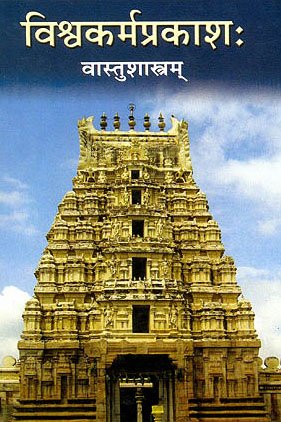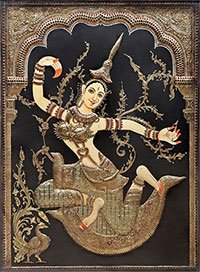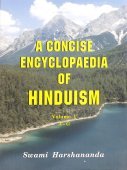Vesara, Veshara, Veśara: 17 definitions
Introduction:
Vesara means something in Buddhism, Pali, Hinduism, Sanskrit, Jainism, Prakrit, biology. If you want to know the exact meaning, history, etymology or English translation of this term then check out the descriptions on this page. Add your comment or reference to a book if you want to contribute to this summary article.
The Sanskrit term Veśara can be transliterated into English as Vesara or Veshara, using the IAST transliteration scheme (?).
In Hinduism
Vastushastra (architecture)
Source: Shodhganga: Temples of Salem region Up to 1336 ADVesara (वेसर).—A classification of prāsada (‘superstructure of a temple’);—Vesara is the building with a circular or apsidal śikhara. See the Suprabhedhāgama, Kriya 30.41, Padmasaṃhita 9.3 and the Mayamata 19.38.
Source: OpenEdition books: Architectural terms contained in Ajitāgama and RauravāgamaVesara (वेसर) refers to “n. of a type of prāsāda §§ 3.3, 28, 32; 4.11.”.—(For paragraphs cf. Les enseignements architecturaux de l'Ajitāgama et du Rauravāgama by Bruno Dagens)

Vastushastra (वास्तुशास्त्र, vāstuśāstra) refers to the ancient Indian science (shastra) of architecture (vastu), dealing with topics such architecture, sculpture, town-building, fort building and various other constructions. Vastu also deals with the philosophy of the architectural relation with the cosmic universe.
Ayurveda (science of life)
Veterinary Medicine (The study and treatment of Animals)
Source: Shodhganga: Portrayal of Animal Kingdom (Tiryaks) in Epics An Analytical studyVesara (वेसर) (lit. “one who moves”) is a synonym (another name) for the Hawk/Falcon (Śyena), according to scientific texts such as the Mṛgapakṣiśāstra (Mriga-pakshi-shastra) or “the ancient Indian science of animals and birds” by Hamsadeva, containing the varieties and descriptions of the animals and birds seen in the Sanskrit Epics such as the Ramayana and Mahabharata.

Āyurveda (आयुर्वेद, ayurveda) is a branch of Indian science dealing with medicine, herbalism, taxology, anatomy, surgery, alchemy and related topics. Traditional practice of Āyurveda in ancient India dates back to at least the first millenium BC. Literature is commonly written in Sanskrit using various poetic metres.
Jyotisha (astronomy and astrology)
Source: Wisdom Library: Brihat Samhita by VarahamihiraVeśara (वेशर) refers to “mules”, according to the Bṛhatsaṃhitā (chapter 16) (“On the planets—graha-bhaktiyoga”), an encyclopedic Sanskrit work written by Varāhamihira mainly focusing on the science of ancient Indian astronomy astronomy (Jyotiṣa).—Accordingly, “[...] Mercury also presides over painters, grammarians, mathematicians, physicians, sculptors, spies, jugglers, infants, poets, rogues, tale-bearers, black-magicians, messengers, eunuchs, buffoons, sorcerers and conjurers; over sentinels, dancers and dancing masters; over ghee, gingelly and other oils; over seeds, over bitter flavour, over observers of religious ceremonies, over chemists and mules (veśara)”.

Jyotisha (ज्योतिष, jyotiṣa or jyotish) refers to ‘astronomy’ or “Vedic astrology” and represents the fifth of the six Vedangas (additional sciences to be studied along with the Vedas). Jyotisha concerns itself with the study and prediction of the movements of celestial bodies, in order to calculate the auspicious time for rituals and ceremonies.
Sports, Arts and Entertainment (wordly enjoyments)
Source: archive.org: Syainika Sastra of Rudradeva with English Translation (art)Vesara (वेसर) refers to one of the eight kinds of Yellow-Eyed Hawks (known as the Pāṭalākṣā division), according to the Śyainika-śāstra: a Sanskrit treatise dealing with the divisions and benefits of Hunting and Hawking, written by Rājā Rudradeva (or Candradeva) in possibly the 13th century.—Accordingly, [while discussing the training of hawks]: “There are different ways of taming them according to the species to which they belong. There are two distinctly separate divisions, namely, ‘black-eyed’ and ‘yellow-eyed’ [e.g., Vesara/Vesārā]. The subdivisions of these are many. ”.
The Vesaras are of three kinds,
- Māṇika,
- Cūlikāṅka,
- Vāsāpratima.

This section covers the skills and profiencies of the Kalas (“performing arts”) and Shastras (“sciences”) involving ancient Indian traditions of sports, games, arts, entertainment, love-making and other means of wordly enjoyments. Traditionally these topics were dealt with in Sanskrit treatises explaing the philosophy and the justification of enjoying the pleasures of the senses.
In Buddhism
Tibetan Buddhism (Vajrayana or tantric Buddhism)
Source: academia.edu: The Structure and Meanings of the Heruka MaṇḍalaVesara (वेसर) is the name of a Vīra (hero) who, together with the Ḍākinī named Vesarī forms one of the 36 pairs situated in the Medinīcakra, according to the 10th century Ḍākārṇava chapter 15. Accordingly, the medinīcakra refers to one of the three divisions of the dharma-puṭa (‘dharma layer’), situated in the Herukamaṇḍala. The 36 pairs of Ḍākinīs and Vīras [viz., Vesara] are yellow in color; the shapes of their faces are in accordance with their names; they have four arms; they hold a skull bowl, a skull staff, a small drum, and a knife.

Tibetan Buddhism includes schools such as Nyingma, Kadampa, Kagyu and Gelug. Their primary canon of literature is divided in two broad categories: The Kangyur, which consists of Buddha’s words, and the Tengyur, which includes commentaries from various sources. Esotericism and tantra techniques (vajrayāna) are collected indepently.
Biology (plants and animals)
Source: Google Books: CRC World Dictionary (Regional names)Vesara in Nigeria is the name of a plant defined with Zea mays in various botanical sources. This page contains potential references in Ayurveda, modern medicine, and other folk traditions or local practices It has the synonym Zea mays f. variegata (G. Nicholson) Beetle (among others).
Example references for further research on medicinal uses or toxicity (see latin names for full list):
· Species Plantarum (1753)
· The American Botanist and Florist (1870)
· A Manual of Botany for the Northern States (1818)
· Taxon (1987)
· Bulletin of the Torrey Botanical Club (1894)
· Annales des Sciences Naturelles, Botanique (1829)
If you are looking for specific details regarding Vesara, for example health benefits, extract dosage, side effects, pregnancy safety, diet and recipes, chemical composition, have a look at these references.

This sections includes definitions from the five kingdoms of living things: Animals, Plants, Fungi, Protists and Monera. It will include both the official binomial nomenclature (scientific names usually in Latin) as well as regional spellings and variants.
Languages of India and abroad
Sanskrit dictionary
Source: DDSA: The practical Sanskrit-English dictionaryVeśara (वेशर).—A mule.
Derivable forms: veśaraḥ (वेशरः).
--- OR ---
Vesara (वेसर).—A mule; प्रणोदितं वेसरयुग्यमध्वनि (praṇoditaṃ vesarayugyamadhvani) Śiśupālavadha 12.19.
Derivable forms: vesaraḥ (वेसरः).
Source: Cologne Digital Sanskrit Dictionaries: Shabda-Sagara Sanskrit-English DictionaryVeśara (वेशर).—m.
(-raḥ) A mule; also vesara .
--- OR ---
Vesara (वेसर).—m.
(-raḥ) A mule. E. vesa-aran; also veśara .
Source: Cologne Digital Sanskrit Dictionaries: Benfey Sanskrit-English DictionaryVesara (वेसर).—m. A mule.
Source: Cologne Digital Sanskrit Dictionaries: Cappeller Sanskrit-English DictionaryVesara (वेसर).—[masculine] a mule.
Source: Cologne Digital Sanskrit Dictionaries: Monier-Williams Sanskrit-English Dictionary1) Veśara (वेशर):—veśavāra See vesara, vesavāra, [column]3.
2) Vesara (वेसर):—m. (cf. vega-sara; also written veśara) a mule, [Varāha-mihira’s Bṛhat-saṃhitā; Śiśupāla-vadha]
3) n. (used to explain vāsara), [Nirukta, by Yāska iv, 7; 11.]
Source: Cologne Digital Sanskrit Dictionaries: Yates Sanskrit-English Dictionary1) Veśara (वेशर):—(raḥ) 1. m. A mule.
2) Vesara (वेसर):—(raḥ) 1. m. A mule.
Source: DDSA: Paia-sadda-mahannavo; a comprehensive Prakrit Hindi dictionary (S)Vesara (वेसर) in the Sanskrit language is related to the Prakrit word: Vesara.
[Sanskrit to German]
Sanskrit, also spelled संस्कृतम् (saṃskṛtam), is an ancient language of India commonly seen as the grandmother of the Indo-European language family (even English!). Closely allied with Prakrit and Pali, Sanskrit is more exhaustive in both grammar and terms and has the most extensive collection of literature in the world, greatly surpassing its sister-languages Greek and Latin.
Prakrit-English dictionary
Source: DDSA: Paia-sadda-mahannavo; a comprehensive Prakrit Hindi dictionaryVesara (वेसर) in the Prakrit language is related to the Sanskrit word: Vesara.
Prakrit is an ancient language closely associated with both Pali and Sanskrit. Jain literature is often composed in this language or sub-dialects, such as the Agamas and their commentaries which are written in Ardhamagadhi and Maharashtri Prakrit. The earliest extant texts can be dated to as early as the 4th century BCE although core portions might be older.
Kannada-English dictionary
Source: Alar: Kannada-English corpusVēsara (ವೇಸರ):—[noun] one of the three
--- OR ---
Vēsara (ವೇಸರ):—[noun] the male offspring of a donkey and a horse; a mule.
Kannada is a Dravidian language (as opposed to the Indo-European language family) mainly spoken in the southwestern region of India.
See also (Relevant definitions)
Starts with: Vecaral, Vecaravu, Vesaragalte, Vesaragatte, Vesarajja, Vesarajja Sutta, Vesarajjanana, Vesaramarga, Vesarashilpa.
Ends with: Devesara, Dviveshara, Uvvesara.
Full-text (+6): Veshvara, Khesara, Vegasara, Vesari, Vesaragalte, Dviveshara, Vesarashilpa, Vesaramarga, Vesaragatte, Samkarashva, Tuvivecarai, Manika, Vasapratima, Culikanka, Vecaral, Giti, Madhyama, Adhikya, Adhama, Shuddha.
Relevant text
Search found 13 books and stories containing Vesara, Veśara, Vēsara, Vesārā, Veshara; (plurals include: Vesaras, Veśaras, Vēsaras, Vesārās, Vesharas). You can also click to the full overview containing English textual excerpts. Below are direct links for the most relevant articles:
Vishnudharmottara Purana (Art and Architecture) (by Bhagyashree Sarma)
4. The Viṣṇudharmottara-purāṇa and Temple Architecture of India < [Chapter 6 - Modern Relevance of Different Art Forms and Architecture]
Vastu-shastra (5): Temple Architecture (by D. N. Shukla)
Chapter 4 - Prāsāda styles (C): Vesara
Chapter 4 - Prāsāda styles (A): Nāgara
Vāvāṭa-Prāsādas (Vāvaṭa and later Chalukyan or Hoysal style) < [Chapter 12 - History of Hindu Temples (Prāsādas and Vimānas)]
Kashyapa Shilpa-shastra (study) (by K. Vidyuta)
3. The Breadth, Length and Height of the Gopuras < [Chapter 5 - Gopura Lakṣaṇa]
3. Temple Architecture (Prāsāda or Vimānā) < [Chapter 1 - Introduction]
3. Date of the Kāśyapa Śilpaśāstra < [Chapter 2 - Author and his Works]
Cosmetics, Costumes and Ornaments in Ancient India (by Remadevi. O.)
2.3. Nose Ornaments (Vesara) < [Chapter 3 - Ornaments]
2. Different Types of Ornaments (Introduction) < [Chapter 3 - Ornaments]
Early Chola Temples (by S. R. Balasubrahmanyam)
Sikhara < [Chapter XIII - Prasada: Component Parts]
Dravidian Art < [Chapter XIV - Conclusion]
Manasara (English translation) (by Prasanna Kumar Acharya)
Related products
